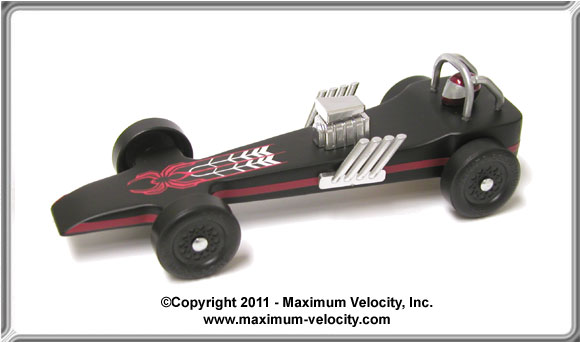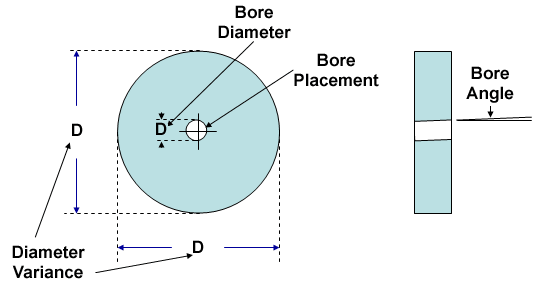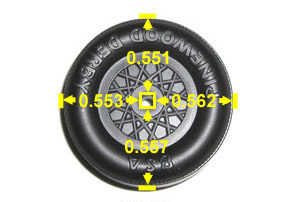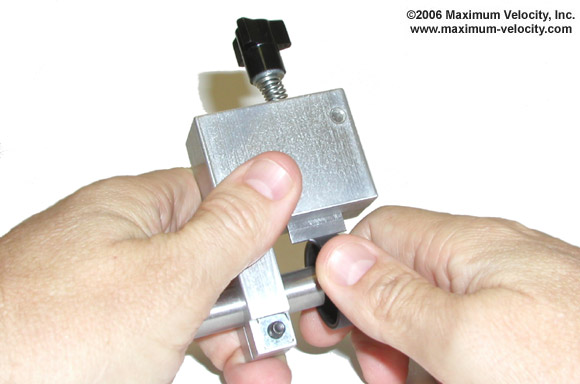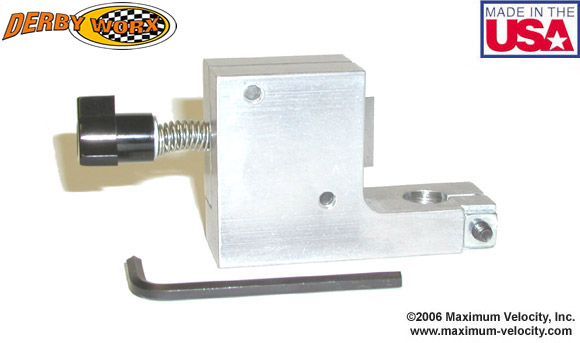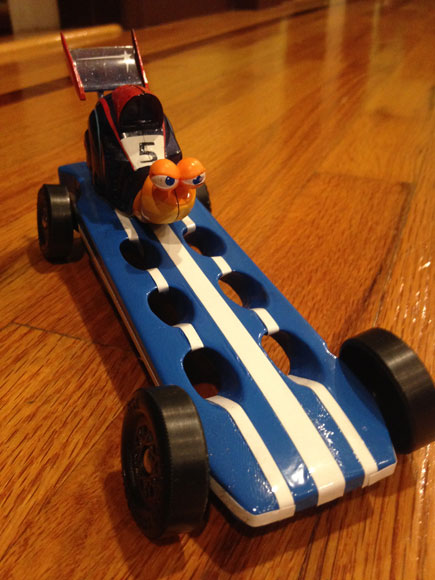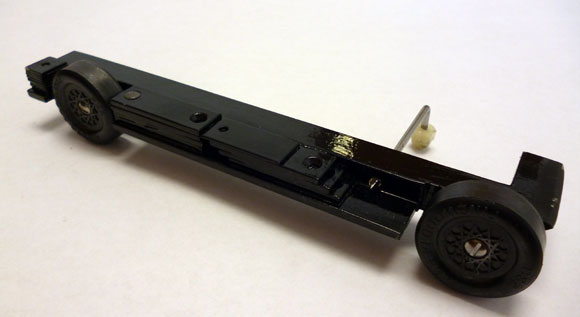– Feature Article – The Wheels Go Round and Round – or Do They?
– Humor
– Product Showcase – Pro-Wheel Shaver XT – 10% Off
– Pinewood Derby Car Showcase
– Pinewood Derby Memory – A Long Wait
– Q&A
Editor’s Notes
Call for Car Photos
The next issue will have an extended car showcase. We have a few photos, but need many more. If we don’t use them in the next issue, we might use them in Volume 18.
So, please send us a photo of your car along with a description of any special features to:
[email protected]
Please include your full name. If selected, we will include the photo and description in this newsletter.
Photos must be sent by e-mail in JPG format (minimum size of 640×480, maximum size of 1280 x 960). Please shoot photos from the front left of the car, similar to the orientation of this car:
Make sure the photo is not blurry. If your photos are blurry, try holding the camera four or five feet away from the car, and then use the camera’s zoom to fill the frame with the car. Also, use a solid (preferably white) background for the photo.
Send only one photo per car, unless an additional photo is needed to adequately show a feature. Don’t forget to include your name, the name of the car (if it has one), and a brief write up on any design features, inspiration for the design, and how the car performed at the race. Thanks.
MV Basic & Wedge Car Kits
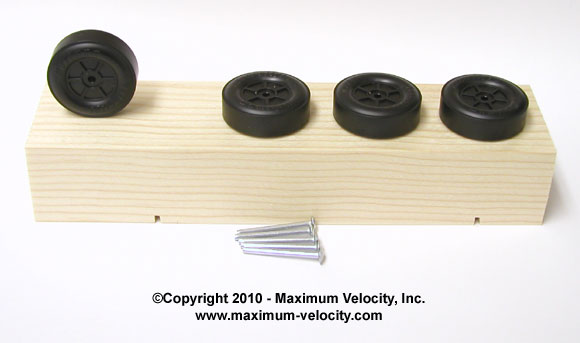
– Quality Block – Unlike the blocks provided by some organizations, our blocks are soft, northwestern pine blocks, cut precisely to 7 inches long, 1-3/4 inches wide, and 1-1/4 inches tall. These dimensions, as well as the axle slots accurately duplicate the dimensions of standard pinewood derby blocks from BSA and PineCar.
– Simple Axle Preparation – Don’t worry about filing off flaws, or losing hub caps. Our Speed Axles have no burrs or crimp marks, and install without hub caps. With or without polishing, they are ready to go. We supply five, so you have a spare.
– Quality Wheels – Forget cheap, out of round wheels. Our MV wheels are top-quality wheels. You will not be disappointed with the quality of these wheels.
So, if your organization does not mandate a particular kit type, consider our MV Basic Car Kits or MV Wedge Car Kits. We also offer bulk packs of MV kits in Pre-cut Shapes.
Inventory Clearance Sale
We are clearing inventory on several items including:
– Tundra and tungsten weights
– Formula One car kits
– Paint Stencils
We don’t have many left, so don’t delay. You can find these items Here.
Can We Help?
If we can help you in any way with your pinewood derby project, or if you have any feedback regarding this newsletter, please contact E-Mail Us.
The Wheels Go Round and Round – or Do They?
By Randy Davis
John Lennon wrote that he loved to spend time “watching the wheels go round and round”, and during this pinewood derby season, kids and parents will have a similar desire. In households all over this country (and in many other countries as well), kids and parents will be opening a pinewood derby car kit – dumping out the block of wood, the axles, and the wheels. As they inspect the contents, they hope that those raw materials will become a fast and good-looking car.
How many kids will build a car this season? I have no idea, but I am sure that the number of kits manufactured per year for consumption in the United States would boggle the mind. Clearly, kit manufacturing is a high-volume business.
In high-volume manufacturing, price is the name of the game. Organizations look for manufacturers who can produce the required quantity of kits on time, and at the lowest price. Quality is certainly considered, but since the product is considered a “toy” or craft item, precision is not generally a factor.
This certainly applies to the pinewood derby wheels. To achieve the required volumes, wheels are injection molded in multi-cavity molds (BSA wheels have sixteen different mold numbers). The intent is that the wheels produced by the various molds will look and perform similarly; and to the casual eye, this is true. But a closer look reveals that:
1. Each mold produces a wheel with unique characteristics, and
2. No mold produces a “perfect” wheel.
Injection molding is great for producing parts cheaply and quickly, but not necessarily with precision.(1)
Wheel Variance
The variance in wheel characteristics from mold to mold can be determined by measurement and by observation. These characteristics include (See Figure 1):
Figure 1 – Wheel Characteristics
– Diameter variance
– Bore angle
– Bore placement
– Bore diameter
Diameter Variance – To achieve best performance, each wheel should of course be perfectly round, and all four wheels should have the same diameter. But in reality, pinewood derby wheels are not perfectly round. Some are close, but others are considerably out of round with an oval or egg-like shape.
Bore Angle – When the bore angle is at 90 degrees to the sidewall, then when spun, the wheel will have no side-to-side wobble. However, as the bore angle deviates from 90, a wobble will be introduced.
Bore Placement – To roll properly, wheels should have the bore placed perfectly in the center of the wheel. Some wheels have the bore virtually perfect, but others have the bore offset several thousandths of an inch. This results in a wheel that tends to “hop” as it rolls.
Bore Diameter – Axles must be smaller than the bore to allow the wheel to spin. But if the bore is too large (or axle too small), the excessive “play” will reduce speed. Generally, the difference between the axle diameter and the wheel bore should be about 5 thousandths of an inch. But on many pinewood derby kits, this difference is closer to 10 thousandths.(2)
The first three characteristics, Diameter Variance, Bore Angle, and Bore Placement, together determine the “trueness” of the wheel. A wheel with zero diameter variance, a 90 degree bore angle, and a perfectly placed wheel bore will spin “true”.
Measuring Trueness
There are several ways to measure the accuracy of a wheel. Calipers can be used to determine if the bore is accurately placed, and to measure the Diameter Variance.
Figure 2 – Bore to Tread Measurements on a Typical BSA Wheel
A second method that combines Bore Placement and Diameter Variance is a Wheel Accuracy Gauge. This tool is generally quite expensive, so they are not commonly used.
A more cost effect way, but one that does not give accuracy in numerical values is the Pro-Wheel Shaver XT. By mounting a wheel on the Pro-Wheel Shaver XT and lifting the blade to just above the tread surface, the Bore Placement and Diameter Variance can be determined subjectively. Then by placing the blade along the inside edge of the wheel, the amount of Bore Angle variance can be found.
Correcting Untrue Wheels
Unfortunately, using a wheel mandrel and some sandpaper will not true a wheel. The sandpaper will remove surface defects, but it cannot remove material in the proper locations to create a perfectly circular wheel.
In fact, until recent years, a machine lathe was the only tool that could true a wheel. However, the Pro-Wheel Shaver XT can be used as an affordable, hand-powered lathe for truing pinewood derby wheels. The shaver mounts on a Pro-Hub tool, the pin of which serves as the center axis for the tool. Click Here for photos and more information on the Pro-Wheel ShaverXT.
Figure 3 – Pro-Wheel Shaver XT with Pro-Hub Tool
Note that a Pro-Hub Tool is required to use the Pro-Wheel Shaver XT.
Alternatives
If you use the official BSA kit, then there are two alternative ways to get better wheels.
1. If your local race allows lathed wheels, and you don’t want to do it yourself with the Pro-Wheel Shaver XT, then consider purchasing wheels that have already been lathed.
2. If your local race does not allow lathed wheels, then note that some of the molds produce superior wheels. By using matched wheels from one of the better molds, better results can be obtained.
Lathed wheels are also available for wheels from Awana, PineCar, MV, and RAs.
Conclusion
If you want to watch your “wheels go round and round” as fast as possible, then consider the characteristics of your wheels. The truer the wheels, the faster they will go round and round!
(1) For more information on injection molding of pinewood derby wheels, see: “The Making of the MV Wheel“. The MV Wheels are more accurate than most other pinewood derby wheels.
(2) A large difference in bore to axle clearance can make an otherwise “true” wheel appear to be faulty. When a wheel is spun on the axle by hand, there is not generally enough mass to hold the wheel bore tightly to the axle. So, the wheel “jumps” around on the axle. It can also “orbit” the axle, a phenomenon which is characterized by a vibration and rapid stopping of the wheel spin. For this reason, hand-spinning wheels on an axle is not generally a good indication of the “trueness” of the wheel. A better test is to spin the wheel on a pin that is one or two thousandths smaller than the bore. This eliminates jumping and orbiting, so that the true quality of the wheel can be observed.
Humor
Q: How can you drop a raw egg onto a concrete floor without cracking it?
A. Concrete floors are very hard to crack!
Q: If it took eight men ten hours to build a wall, how long would it take four men to build it?
A. No time at all since it is already built.
Q: If you had three apples and four oranges in one hand and four apples and three oranges in the other hand, what would you have?
A: Very large hands.
Q: How can you lift an elephant with one hand?
A: It is not a problem, since you will never find an elephant with one hand.
Q: How can a man go eight days without sleep?
A: He sleeps at night.
Q: Why it is impossible to send a telegram to Washington today?
A: Because he is dead.
Q: If you throw a red stone into the blue sea what it will become?
A: It becomes wet.
Q: What often falls but never gets hurt?
A: Rain
Q: What is it that no man ever saw, which never was, but always will be ?
A: Tomorrow
Q: What looks like half an apple?
A: The other half.
Q: What gets wet with drying ?
A: A towel.
Q: What happened when the wheel was invented?
A: It caused a revolution.
Q: Why does a bike rest on its leg?
A: Because it is too tired.
Product Showcase
Pro-Wheel Shaver XT – 10% Off
Sanding the wheels on a wheel mandrel polishes the tread surface, but it does not significantly change the shape of the wheel. In fact, to truly create round wheels, a computer controlled lathe is required. However, this expensive machine is not a practical solution for the casual pinewood derby car builder.
But now anyone can create round pinewood derby wheels. Introducing the Pro-Wheel Shaver XT II, a precision device that will improve the speed of your pinewood derby car by:
– Wheel Diameter Truing – Creating a wheel which is perfectly round,
– Wheel Width Truing – Truing the inside edge of the wheel, removing molding marks and excess material.
Through March 6, 2018, you can get a Pro-Wheel Shaver XT for 10% percent off. To take advantage of this limited time offer, add part 5154 to your shopping cart and use coupon code FEB21NL during checkout.
Pinewood Derby Car Showcase
Turbo – Kevin Moore
This car was inspired by my 8 year old son Dillon’s favorite movie “Turbo”.
Razor’s Edge – Matt Ridzon
“Razor’s Edge” won the Open Class for the 2018 Cub Scout Pack 119 race in New Springfield, OH. During pre-race testing, we found the front wheel was slightly out of round, which caused the car to wobble slightly and occasionally topple. It ran successfully about 50% of the time without toppling. Any time it toppled, it fell leftward, but always manage to continue blazing through the finish line! But to be safe on race day, we decided to install the outrigger (bent finishing nail with nylon bumper on it). The outrigger hovers over the track and only glazes the track if the wheel wobble gets bad enough to knock the car off balance. Placing the weights between wheels was vital for balance. The downside to the design is that the COG is pretty far forward (almost 2 inches in front of the rear axle). My son’s 3-wheel Webelos car actually ran faster than this, but the 2-wheeler made great conversation in the crowd! The car body was so light that 4+ ounces of tungsten weight had to be added to make full weight (5oz). The rear axle is aligned to track straight while the front axle is aligned to steer slightly into the rail.
Share Your Car With Our Readers
Do you have a car you would like to “show off” to our readers? If so, send us a photo of your car along with a description of any special features to:
[email protected]
Please include your full name. If selected, we will include the photo and description in this newsletter.
Photos must be sent by e-mail in JPG format (minimum size of 640×480, maximum size of 1280 x 960). Please shoot photos from the front left of the car, similar to the orientation of this car:
For better focus, keep the camera four or five feet away from the car, and then use the camera’s zoom to fill the frame with the car. Also, use a solid (preferably white) background for the photo.
Send only one photo per car, unless an additional photo is needed to adequately show a feature. Also, only one car per subscriber per year please. Thanks.
Pinewood Derby Memory
A Long Wait
My son, Matthew, just won his first trophy for his first pinewood derby race! Matthew is a Tiger cub this year and he has been enjoying being a Cub Scout tremendously. There is a good story behind his joining, too.
Matt came home with a letter about a Cub Scout recruiting night from his kindergarten class at school last year. He wanted to join and I said I would take him to the meeting. Well, we didn’t know that kindergartners couldn’t join the scouts. All the scouting people felt really bad about disappointing him; he was trying very hard not to cry.
The same recruiting letter came home again this year from first grade and Matt still wanted to be a scout. Again we went to recruiting night and Matt got to officially be a Cub Scout. Well, as it turns out he was the only first grader to join this year so there was no Tigers in our town! Our Cub Scout master was advised to send him to the next town to the Tiger den there. But our Cub Scout master decided to keep Matthew in our community and have him go to the Wolf’s den meetings, and hope that more Tigers would join up (We ended up with two Tigers by the time of the pinewood derby race). I am so grateful that he did, Matthew is a pretty shy boy and has blossomed under his den leader’s guidance.
Matthew and Mom (me) made his car together. He wanted it shaped just like the one on the box, because it had to be fast to get on the box! I did the cutting and he sanded. He was going to spray paint it but his little fingers couldn’t press the button on the can. He put the wheels on and I checked that they were straight. He put decals on it and we got the scale out to check the weight. It weighted three ounces. Matt got some lead weights at the hobby shop and wanted to use them as the seat. so we cut them down and glued them in the “cockpit”. It just happened to be one inch in front of the rear wheels (as I read in one of your stories). It was still a little light so we put “muffler pipes” up out of trunk area. It was 4.95 ounces.
On race day, Matt was so excited about possibly winning a trophy. I kept trying to impress upon him that even if he didn’t win, he could still have fun. When his car came across the finish line in the lead that first time, his face was so excited! I think the whole room cheered for him. He won five out of seven races! He was so proud to get his Tiger cub trophy and even more proud of his car! He still thinks he would have got one of those big trophies if he wasn’t a Tiger. I believe he is right, his car beat the second place finisher three times, but I didn’t ask.
This program does so much for the confidence of little boys like Matthew and everybody has been so great to him.
Lorraine Cressey
Phippsburg, Maine
Do you Remember?
If you have a pinewood derby story that is funny, unusual, sad, heart-warming, etc., please send it to me in an e-mail. Don’t worry about literary polish. We will edit as needed before publishing. If your story is used, you will receive a $10 coupon in May of 2017.
Q&A
Q: I purchased from you a car kit that came with steel weights. They fit nicely in the routed out area on the underside of the car.
I have read numerous articles that say tungsten is the best weight to use because of the density of the metal. My question is: would the performance of the car increase with the use of tungsten weights instead of the steel weights? What is confusing to me is if I need 3 ounces of weight, what difference does it make if I use 3 ounces of steel or 3 ounces of tungsten?
A: We offer some cars with steel weight to keep the price down. The balance point typically ends up at about 1 inch in front of the rear axle.
If you substitute tungsten for steel in equal weight amounts, so that the weight distribution between the front and rear pocket is unchanged from steel to tungsten, then there is no advantage to tungsten weight.
But, if you want the balance point closer to the rear axle, then you could substitute tungsten for steel in the rear pocket. Since tungsten is denser than steel, you can put more weight behind the rear axle, thus moving the balance point closer to the rear axle. Just make sure you check the balance point. It is possible that if you fill the rear pocket with tungsten (because the pocket is large) you could end up with a balance point that is too aggressive, leading to instability.
Generally, as you make the balance point more aggressive, you need to implement rail-riding alignment to ensure stability.
Q: I am building a car with my son and we are making a thin flat car this year. Your site was recommended for supplies. What is the best tungsten weights to use? There are so many to choose from on your site.
A: It depends on how you plan to add weight.
Choice 1 – 9/32 Tungsten Rod – Relatively Easy – If you have access to a drill press, then you can drill holes in the side of the car for tungsten rods. We also offer the correct drill bit, Part 5004.
Choice 2 – 1/4 inch Tungsten Cubes – Harder – This requires making pockets under the car to hold the cubes. However, this is likely the most popular method for weighting thin cars.
Choice 3 – Tungsten Snap-Off Plates – Easiest – This is the easiest method, as the plates attach to the bottom of the car (the clearance spec will be met). However, this method does not generally provide as aggressive of a COG as the other two methods.
There are other ways, specifically using tungsten canopies, but the above three are the most common methods.
Want Answers?
Do you have a pinewood derby-related question? If so, e-mail us your question.We answer all questions by e-mail, but not every question will appear in the Q&A section of the newsletter.
Back Issues
Are you a new subscriber, or have you missed some of the previous newsletters? Don’t miss out; all of the issues for Volume 5 through Volume 17 are posted on our web site Here.
Newsletter Contributions
We welcome your contributions. If you would like to contribute an article, a web site review, a speed tip, or a pinewood derby memory, please e-mail us.
Subscription Information
The Pinewood Derby Times is a free e-newsletter focused on pinewood derby racing. It is published biweekly from October through March.
If you haven’t already done so, please forward this issue to your pinewood derby friends. But please don’t subscribe your friends. Let them decide for themselves. Thanks.
If this newsletter was forwarded to you, why not subscribe to receive this newsletter. There is no cost, and your e-mail address is safe, as we never sell or share our distribution list.
To subscribe, send a blank e-mail to
[email protected]
You will receive a confirmation e-mail. Reply to the confirmation e-mail and you will start receiving the Pinewood Derby Times with the next issue.
Randy Davis, Editor, Pinewood Derby Times
E-Mail: [email protected]
(C)2018, Maximum Velocity, Inc. All rights reserved. Please do not reprint or place this newsletter on your web site without explicit permission. However, if you like this newsletter we grant permission, and encourage you to e-mail it to a friend.
Maximum Velocity disclaims any personal loss or liability caused by utilization of any information presented in this newsletter.
The Pinewood Derby Times is not specific to, and is not affiliated with the Boy Scouts of America, YMCA, Awana, or any other organization.
(R)Maximum Velocity is a registered trademark of Maximum Velocity, Inc.
(R)Pinewood Derby is a registered trademarks of the Boys Scouts of America.
(R)Awana is a registered trademark of Awana Clubs International.
All other names are trademarks of their respective owners.

